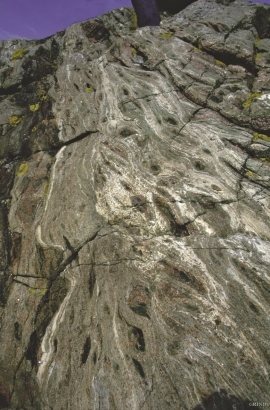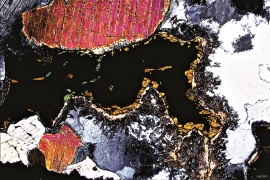Published: 07.08.2015 | Author: Haakon Fossen, Håkon Austrheim
Eclogite bedrock at Ådnefjellet. Toward Radfjorden and Radøy. (Svein Nord)
HORDALAND'S HEAVIEST STONE
The eclogites in western Norway were formed when Precambrian basement rocks were squeezed and pressed down under great pressure deep under the Caledonian mountain chain. The process may well have triggered some of the deepest earthquakes the world has ever known. The clearest traces of this drama are found in and around Mt. Eldsfjellet, in peaceful Meland.
The name eclogite comes from Greek, and suggests something like "first choice". This is related to its beautiful appearance. The nutrient-depleted rock type is slow to weather, such that eclogite bedrock is left standing as peaks in the terrain. This is why Mt. Eldsfjellet has become a landmark on the coast.
The world famous geologists Carl Fredrik Kolderup and Pentti Eskola mentioned the eclogites on Holsnøy early in the 1900s. At that time it was not known how the rock type was formed. Now we know that it is created in areas where the rock gets pressed down to quite deep depths in connection with collisions that force one continental plate under another.
The material forming the eclogites was anorthositic and mangeritic rock types originating in the lower part of the earth's crust. They were formed at about 30 kilometres depth and at temperatures of 800-900°C and were therefore well prepared for an even deeper geological dive: During the collision between Greenland and Norway about 420 million years ago, they were pressed down to more than 50 kilometres under the earth's surface. This submersion caused the older minerals to be replaced by new. The molecular structure also became denser. Therefore, the rock type shrank in size by about 10-15 percent, and this made it heavier than before. Geologists believe that this shrinking caused movements in the bedrock, and that the shrinking thereby triggered some of the deepest earthquakes that have ever occurred on earth.
Geologists also believe that the warm fluids that seeped into the bedrock were important for the creation of the eclogite. Only where fluids streamed into the bedrock, namely, was eclogite the result. The fluids seeped in most easily where the bedrock because of shrinking got fractured and moved. Where there is most fracturing, thick zones of nearly pure eclogite are found. A good example of this can be seen on the southeast side of Sætrevika.
If the homesteads there did not get in the way, there could perhaps have been industrial mineral extraction on Holsnøy. The mineral rutile, which is found in eclogite, can namely be used instead of ilmenite as a source of titanium.
Titanium is used for the white colouring in paint and for light-metal alloys in bicycle frames, planes and other products. The production of titanium from ilmenite, such as is carried out i.e. in Tyssedal in Hardanger, is more polluting than the use of rutile. During the formation of eclogite on Holsnøy, an environmentally dangerous manufacturing process occurred 420 million years ago. Then, ilmenite and feldspar were unstable under the high pressures, so that they were altered to the minerals rutile and garnet. Rutile, which can only be seen under a microscope, is a titanium oxide that both forms small needles in other minerals and free standing grains of rutile. Rutile is found i.e. in a mica-rich bedrock by Landsvik, and in the ecologites north of the shop in Sætrevika.
Eclogite
Eclogite stone is comprised of a greenish coloured pyroxene, speckled with small, reddish garnet crystals. The rock type has a specific gravity as high as 3.5 g/cm³, as a consequence of its being formed at great depth where the pressure is high. The Holsnøy eclogites have specific gravities of about 3.2 g/cm3. In comparison, continental crust has a specific gravity on average of 2.7 g/cm³.
The mineral rutile, which is found in Meland, can only be seen under the microscope. Rutile is the brown trim around the edge of the black area in the middle of the picture. The black area is ilmenite, which is partially altered to rutile along its edge. The breadth of the picture is about 7 mm. (Haakon Fossen)
Mountaint plateau to the west
Far toward the west, by the edge of Hjelte Fjord, Meland has its own mountain plateau, geologically related to Hardangervidda and Vidden in Bergen. The large, relatively flat plateau on Eldsfjellet is a remnant of an older landscape, a plateau landscape that was formed during the earth's Mesozoic Era. Later, early in the Cenozoic Era, the large plateau landscape got lifted up. With the cutting power of rivers, deep valleys were carved. In the end, the glaciers took over from the rivers with even greater cutting power. The valleys were carved wider and deeper, some so deep that they became fjords. Only a few places in the county were spared from this carving work. That the remains of the mountain plateau on Eldsfjellet have survived so far to the west is due to the hard bedrock eclogite, that is very resistant to nature's destructive forces.
Along the highway from Rossland to Landsvik, the transition from strandflat to mountainous terrain is sharp. On the north- and west sides, however, the mountains rise more evenly toward the top. At the plateau itself there are some small valleys and lakes. The valleys are carved out along fracture zones by glaciers that went along the tops during the ice ages.
- Austrheim, H.; Griffin, W. L. 1985. Shear deformation and eclogite formation within granulite-facies anorthosites of the Bergen Arcs. Chemical Geology 50: 267–281.







